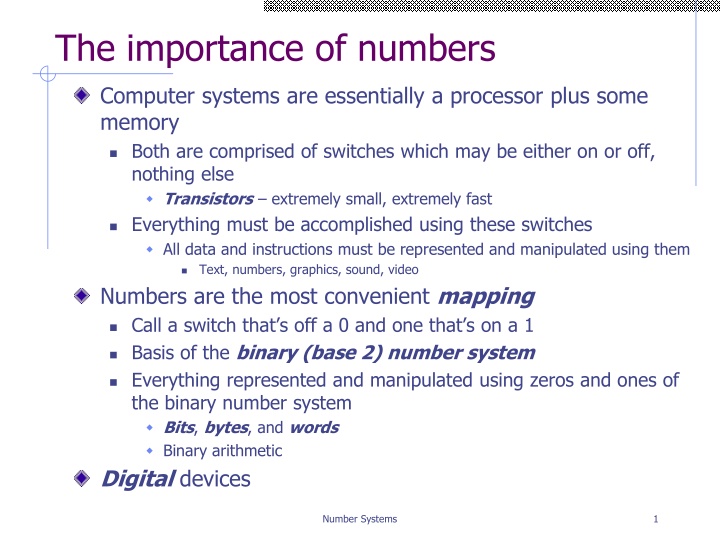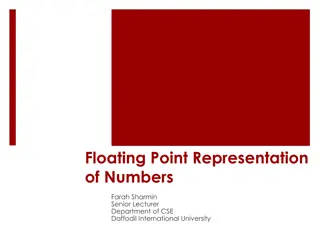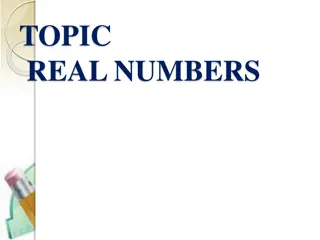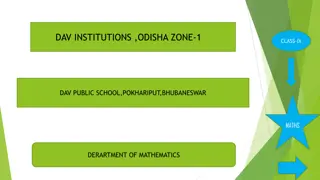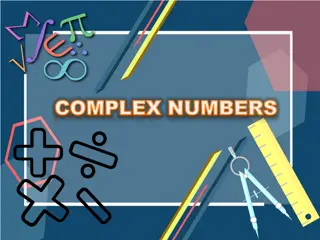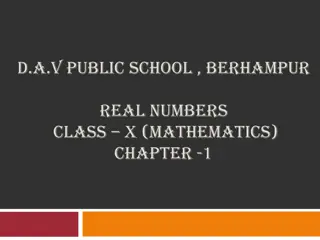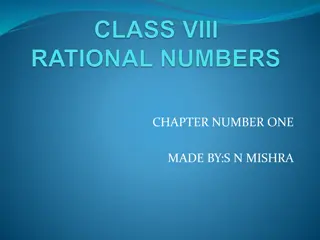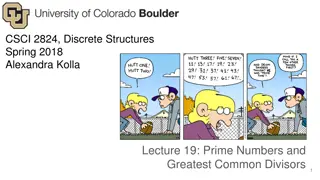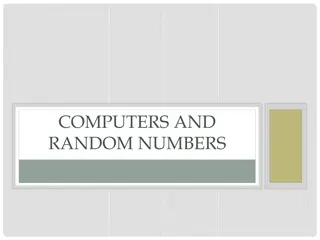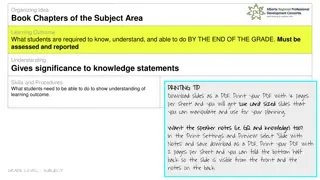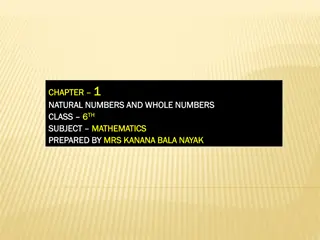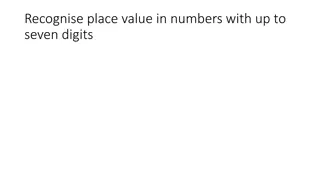The Importance of Numbers in Computer Systems
Computer systems rely on numbers represented in binary form. This binary system uses switches that are either on (1) or off (0) to manipulate data. Various number systems, including decimal, binary, hexadecimal, and octal, play a crucial role in digital devices. Counting and positional notation are fundamental concepts in understanding number systems. The ability to convert between different bases is essential in computing.
Download Presentation

Please find below an Image/Link to download the presentation.
The content on the website is provided AS IS for your information and personal use only. It may not be sold, licensed, or shared on other websites without obtaining consent from the author.If you encounter any issues during the download, it is possible that the publisher has removed the file from their server.
You are allowed to download the files provided on this website for personal or commercial use, subject to the condition that they are used lawfully. All files are the property of their respective owners.
The content on the website is provided AS IS for your information and personal use only. It may not be sold, licensed, or shared on other websites without obtaining consent from the author.
E N D
Presentation Transcript
The importance of numbers Computer systems are essentially a processor plus some memory Both are comprised of switches which may be either on or off, nothing else Transistors extremely small, extremely fast Everything must be accomplished using these switches All data and instructions must be represented and manipulated using them Text, numbers, graphics, sound, video Numbers are the most convenient mapping Call a switch that s off a 0 and one that s on a 1 Basis of the binary (base 2) number system Everything represented and manipulated using zeros and ones of the binary number system Bits, bytes, and words Binary arithmetic Digital devices Number Systems 1
Pop quiz! How many stars are there? a) 1100 b) 12 c) 14 d) C e) All of the above Number Systems 2
Pop quiz the fairer version! How many stars are there? a) 11002 b) 1210 c) 148 d) C16 e) All of the above Number Systems 3
Number systems common in IT Decimal (base 10) Digits: 0, 1, 2, 3, 4, 5, 6, 7, 8, 9 Binary (base 2) Digits: 0, 1 Hexadecimal (base 16) Digits: 0, 1, 2, 3, 4, 5, 6, 7, 8, 9, A, B, C, D, E, F Octal (base 8) Digits: 0, 1, 2, 3, 4, 5, 6, 7 Number Systems 4
Counting reviewed Start at 0 Add 1 for each item being counted Groups of 1 (100) When you reach 10 (the base), return to 0 and carry a 1 into the place to the left Groups of 10 (101) When you reach 10 (the base) in any place, return to 0 in that place and carry a 1 into the place to the left Groups of 100 (102), 1,000 (103), 10,000 (104) Positional notation and weights 823 = 8 x 102 + 2 x 101 + 3 x 100 8 x 100 + 2 x 10 + 3 x 1 800 + 20 + 3 = 823 0 1 2 9 10 11 12 19 20 21 22 99 100 101 Number Systems 5
Counting in other bases Same mechanics Assume generic base B Start at 0 Add 1 for each item being counted Groups of 1 (B 0) When you reach B (the base), return to 0 and carry a 1 into the place to the left Groups of B (B 1) When you reach B (the base) in any place, return to 0 in that place and carry a 1 into the place to the left Groups of B 2, B 3, B 4 Positional notation and weights 413B = 4 x B2 + 1 x B1 + 3 x B0 If B=5, 4135 = 4 x 52 + 1 x 51 + 3 x 50 4 x 25 + 1 x 5 + 3 x 1 100 + 5 + 3 = 10810 Can convert any whole number in any base to decimal 0 1 2 3 4 10 11 12 13 14 20 21 22 44 100 101 Number Systems 6
Ranges and limits If the base is B, the largest digit is B - 1 The total range of values for an n-digit number is B n, starting at 0 and ending at B n - 1 6-digit decimal numbers have a range of 106 (or 1,000,000) values, ranging from 0 to 999,999 6-digit binary numbers have a range of 26 (or 64) values, ranging from 0 to 63 6-digit hex numbers have a range of 166 (or 16,777,216) values, ranging from 0 to 16,777,215 Computers store and manipulate values as groups of bits An 8-bit byte has a range of 28 (or 256) values, ranging from 0 to 255 A 16-bit word has a range of 216 (or 65,536 or 64K) values, ranging from 0 to 65,535 A 32-bit word has a range of 232 (or 4,294,967,296 or 4G) values, ranging from 0 to 4,294,967,295 A 64-bit word has a range of 264 (or 18,446,744,073,709,551,616) values, ranging from 0 to 18,446,744,073,709,551,615 (16E) Number Systems 7
Converting any base to decimal I The weights method Multiply each digit by the appropriate weight and sum the results 1011012 = 1 x 25 + 0 x 24 + 1 x 23 + 1 x 22 + 0 x 21 + 1 x 20 1 x 32 + 1 x 8 + 1 x 4 + 1 x 1 32 + 8 + 4 + 1 = 4510 20AF16 = 2 x 163 + 0 x 162 + A x 161 + F x 160 2 x 4096 + 10 x 16 + 15 x 1 8192 + 160 + 15 = 836710 Number Systems 8
Converting any base to decimal II The multiplication method Start with the most significant digit, multiply that digit by the base and add the next digit to the right, multiply the result by the base again and add the next digit to the right, keep multiplying and adding digits until all the digits have been used 1011012 = 1 x 2 = 2 + 0 = 2 x 2 = 4 + 1 = 5 x 2 = 10 + 1 = 11 x 2 = 22 + 0 = 22 x 2 = 44 + 1 = 4510 20AF16 = 2 x 16 = 32 + 0 = 32 x 16 = 512 + 10 = 522 x 16 = 8352 + 15 = 836710 Number Systems 9
Converting any base to decimal III The multiplication method reworded Initialize a to 0, working from the most significant digit to the least significant (left to right), add the value of the next unused digit to a to get a new a, if there are unused digits remaining multiply a by the base to get a new a before adding the next digit, if there are no unused digits left, the value of a is the answer expressed in decimal 1011012 = 0 + 1 = 1 x 2 = 2 + 0 = 2 x 2 = 4 + 1 = 5 x 2 = 10 + 1 = 11 x 2 = 22 + 0 = 22 x 2 = 44 + 1 = 4510 20AF16 = 0 + 2 = 2 x 16 = 32 + 0 = 32 x 16 = 512 + 10 = 522 x 16 = 8352 + 15 = 836710 Number Systems 10
Converting decimal to other bases I The largest weight method Start with the largest possible weight that s less than the value being converted and determine the digit for that weight based upon how many times the weight fits into the value, then subtract that digit times the weight from the value and repeat until the difference is 0 Convert 4610 to binary: largest weight that fits is 32, digit must be 1, 46 32 = 14 largest weight that fits is 8, digit must be 1, 14 8 = 6 largest weight that fits is 4, digit must be 1, 6 4 = 2 largest weight that fits is 2, digit must be 1, 2 2 = 0, so stop answer has 1 s in 32s, 8s, 4s, and 2s places: 1011102 Convert 836710 to hexadecimal: largest weight that fits is 4096 (163), goes in 2 times, so digit is 2 8367 (4096 x 2) = 8367 8192 = 175 256 (162) doesn t fit, so that digit is 0 largest weight that fits is 16 (161), goes in 10 times, so digit is A 175 (16 x 10) = 175 160 = 15 largest weight that fits is 1 (160), goes in 15 times, so digit is F 15 (15 x 1) = 15 15 = 0, so stop putting digits together, answer is 20AF16 Number Systems 11
Converting decimal to other bases II The division method Divide the number being converted by the desired base, noting the quotient and remainder; record the remainder as the next digit in the answer (building the answer up right to left); repeat using the quotient until the quotient is 0 Convert 4610 to binary: 46/2 = Q23 R0: answer so far: 02 23/2 = Q11 R1: answer so far: 102 11/2 = Q5 R1: answer so far: 1102 5/2 = Q2 R1: answer so far: 11102 2/2 = Q1 R0: answer so far: 011102 1/2 = Q0 R1: answer so far: 1011102 quotient is 0, so stop with final answer: 1011102 Convert 836710 to hexadecimal: 8367/16 = Q522 R15: answer so far: F16 522/16 = Q32 R10: answer so far: AF16 32/16 = Q2 R0: answer so far: 0AF16 2/16 = Q0 R2: answer so far: 20AF16 quotient is 0, so stop with final answer: 20AF16 Number Systems 12
Binary, hexadecimal and octal Computers use binary Unwieldy for humans Humans prefer decimal Unsuitable for computers Hexadecimal (hex) and octal are good compromises More efficient than binary Hex is more efficient than decimal too Since these bases are powers of 2, they re easily converted to and from binary Counting, arithmetic, and conversions to decimal use the same mechanics as any other base Number Systems 13
Binary to octal conversions 8 = 23, so each octal digit matches exactly three binary digits Binary to octal is a simple 1 for 3 substitution Working right to left, break the binary value into 3-bit chunks Add leading 0s as needed to make the last 3-bit chunk Substitute the appropriate octal digit for each 3-bit chunk Octal to binary is a simple 3 for 1 substitution Oct 0 1 2 3 4 5 6 7 Bin 000 001 010 011 100 101 110 111 Dec 0 1 2 3 4 5 6 7 010 2 000 0 101 5 111 7 1 6 3 2 001 110 011 010 Number Systems 14
Binary to hexadecimal conversions 16 = 24, so each hex digit matches exactly four binary digits Binary to hex is a simple 1 for 4 substitution Working right to left, break binary value into 4-bit chunks Add leading 0s as needed to make the last 4-bit chunk Substitute the appropriate hex digit for each 4-bit chunk Hex to binary is a simple 4 for 1 substitution Hex 0 1 2 3 4 5 6 7 Bin 0000 0001 0010 0011 0100 0101 0110 0111 Dec 0 1 2 3 4 5 6 7 Hex 8 9 A B C D E F Bin 1000 1001 1010 1011 1100 1101 1110 1111 Dec 8 9 10 11 12 13 14 15 0100 4 0010 2 1111 F 3 9 A 0011 1001 1010 Number Systems 15
Addition basics Decimal 1 1 2 4 5 9 7 5 + + + 12 Binary 0 0 0 0 1 1 1 0 1 1 1 + + + + 10 1 1 1 1 1 89 1 0 1 0 1 1 0 1 0 1 0 0 1 0 1 0 1 1 0 + 51 140 + 1 0 Number Systems 16
Multiplication basics Decimal 12 0 0 12 1 12 12 2 24 12 10 120 x x x x Binary 0 0 0 0 1 0 1 0 0 1 1 1 x x x x 1 0 1 1 0 0 1 1 1 0 0 1 0 1 0 1 1 0 0 1 1 0 1 1 0 0 1 + 1 0 1 1 0 0 1 1 0 0 0 1 0 1 1 0 0 0 1 0 89 50 x x 4450 Number Systems 17
Understanding fractions Fractional values do not always have exact equivalents in all bases So we re often forced to settle for approximations A radix point is used when representing fractions Weights to the left of the radix point are positive powers of the base Moving the radix point one digit to the right multiplies the value by the base (37.34 373.4) Weights to the right of the radix point are negative powers of the base 1/10, 1/100, 1/1000, etc. in decimal 1/2, 1/4, 1/8, 1/16, etc. in binary Moving the radix point one digit to the left divides the value by the base (373.4 37.34) Number Systems 18
Some fractional examples .82310 = 8 x 10-1 + 2 x 10-2 + 3 x 10-3 8 x 1/10 + 2 x 1/100 + 3 x 1/1000 .8 + .02 + .003 = .82310 .10112 = 1 x 2-1 + 0 x 2-2 + 1 x 2-3 + 1 x 2-4 1 x 1/2 + 1 x 1/8 + 1 x 1/16 1 x .5 + 1 x .125 + 1 x .0625 .5 + .125 + .0625 = .687510 .A3E16 = 10 x 16-1 + 3 x 16-2 + 14 x 16-3 10 x 1/16 + 3 x 1/256 + 14 x 1/4096 10 x .0625 + 3 x .00390625 + 14 x .000244140625 .625 + .01171875 + .00341796875 = .6401367187510 Number Systems 19
Converting fractions to other bases Multiply the number being converted by the desired base, noting the digit that moves to the left of the radix point; record that as the next digit in the answer (working left to right); repeat using the fractional part until it s 0 or the desired accuracy is achieved Convert .39310 to binary with six places: .393 x 2 = 0.786: answer so far: .02 .786 x 2 = 1.572: answer so far: .012 .572 x 2 = 1.144: answer so far: .0112 .144 x 2 = 0.288: answer so far: .01102 .288 x 2 = 0.576: answer so far: .011002 .576 x 2 = 1.152: answer so far: .0110012 That s six places, so the final answer is: .0110012 Convert .84210 to hexadecimal with six places: .842 x 16 = 13.472: answer so far: .D16 .472 x 16 = 7.552: answer so far: .D716 .552 x 16 = 8.832: answer so far: .D7816 .832 x 16 = 13.312: answer so far: .D78D16 .312 x 16 = 4.992: answer so far: .D78D416 .992 x 16 = 15.872: answer so far: .D78D4F16 That s six places, so the final answer is: .D78D4F16 Number Systems 20
Working with mixed numbers Mixed numbers have both an integer part and a fractional part The arithmetic rules are the same regardless of the base Remember to align the radix points when adding and subtracting Conversions are done in two stages Convert the integer part Convert the fractional part Combine the results, keeping the radix point between them Number Systems 21
